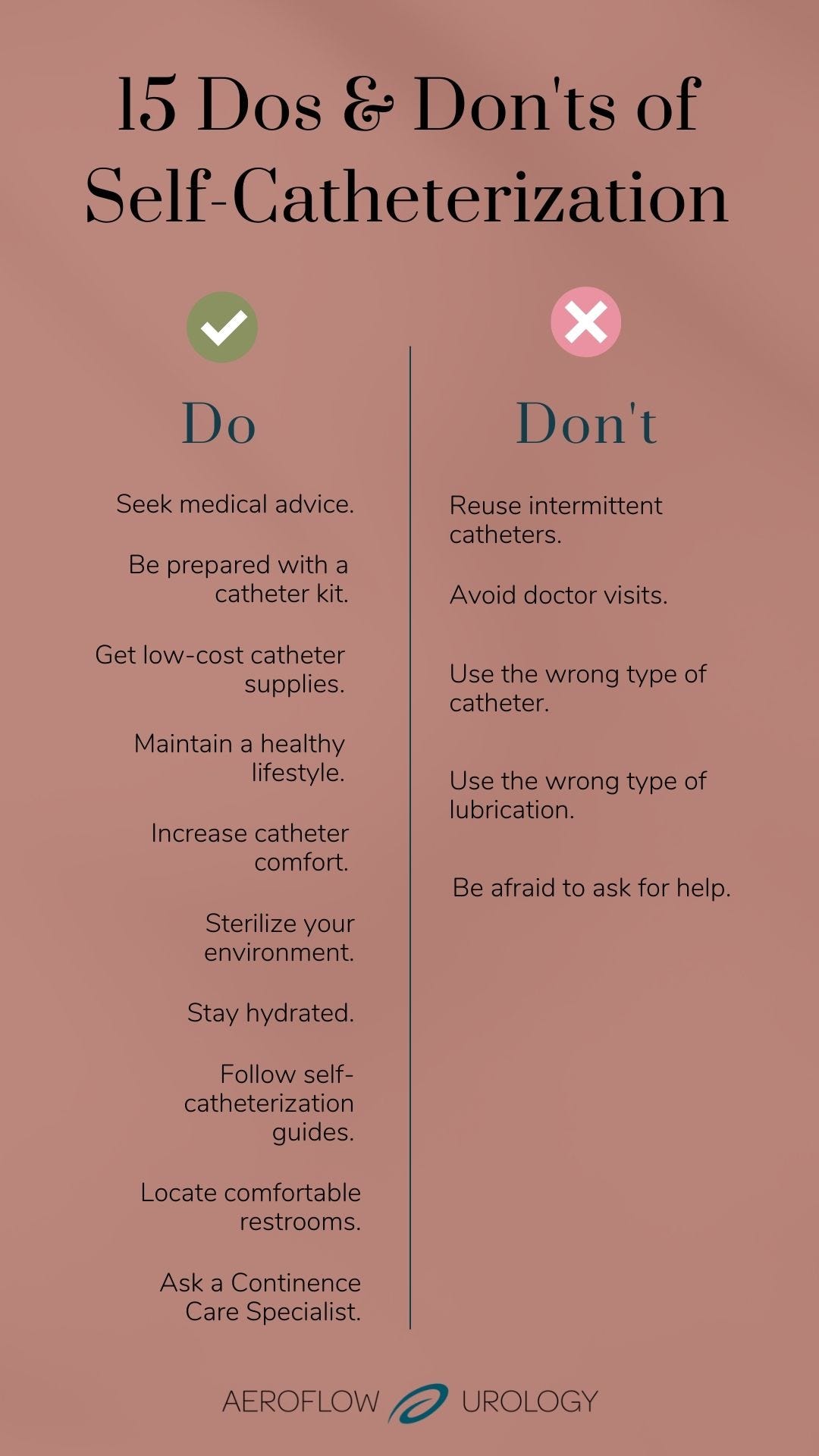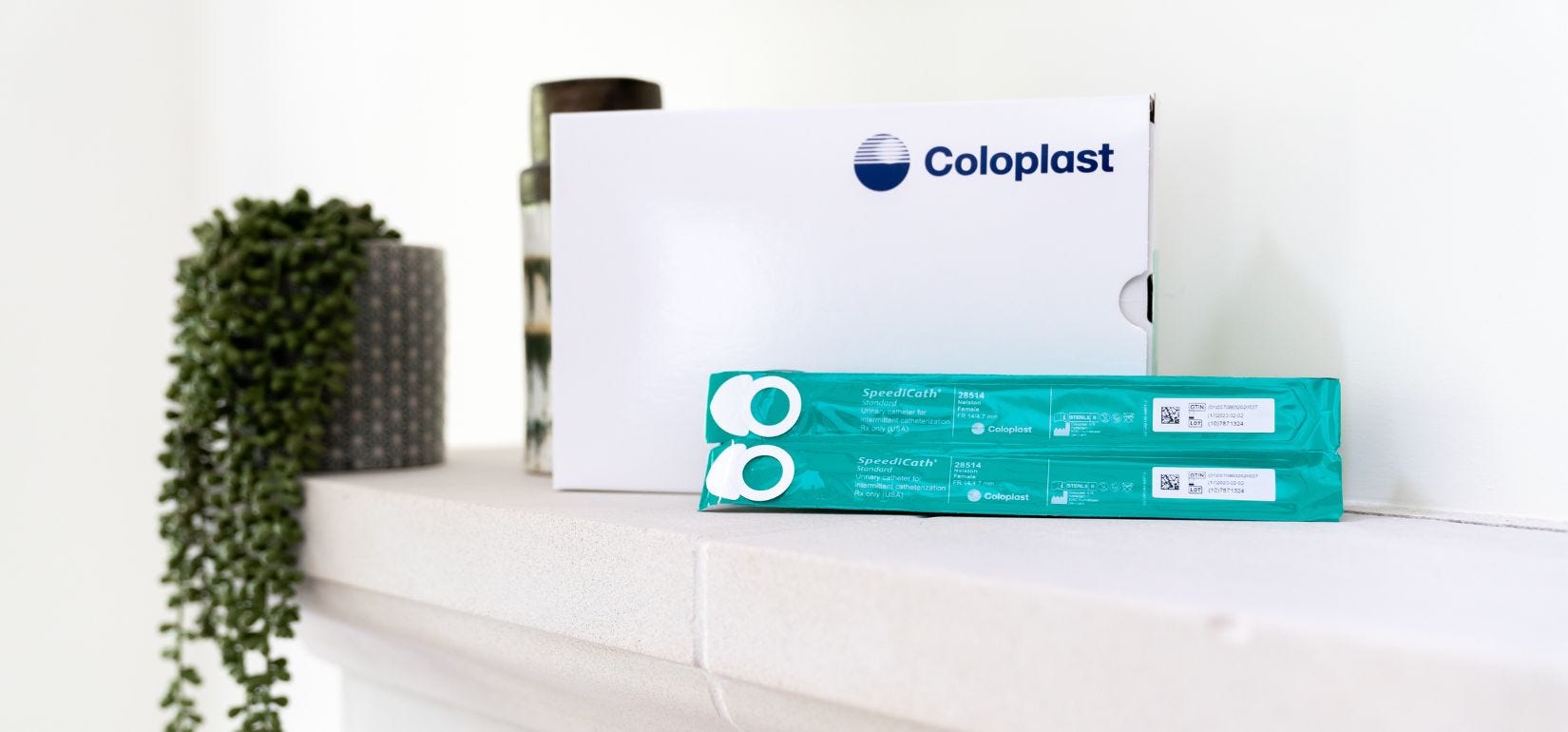From sanitizing surfaces to finding the right sizes, intermittent self-catheterization is an intricate process that can seem challenging to memorize when first starting out.
Even if you're a long-time catheter user, you probably have some lingering questions that haven't been answered yet.
In this post, we'll tell you 15 of the top dos and don’ts of intermittent catheterization so you can be confident when changing your catheter at home or wherever you need to drain your bladder.
What Is an Intermittent Catheter?
Check Your Eligibility
2 Easy Steps
Discover the catheter supplies covered by your insurance.
An intermittent catheter is a type of catheter that allows you to self-catheterize outside of a healthcare provider’s office.
Providers prescribe intermittent catheters to help drain the urine from your bladder when your body can't empty urine on its own.
Intermittent catheters are inserted through your urethra and placed inside your bladder where they rest while you urinate. During urination with an intermittent catheter, your urine passes through the tip of the catheter, flows down the tube, and empties out the opposite end. After your flow of urine stops, you remove the catheter from your bladder and dispose of it.
You may require an intermittent catheter if you experience:
- Urinary incontinence (loss of bladder control).
- Urinary retention (inability to empty your bladder completely).
- Urinary tract obstructions, such as bladder stones or a swollen prostate gland.
- Prostate or genital surgery.
- Dementia
- Neurogenic bladder.
- Spinal cord injury or bladder injury.
- Spina bifida, multiple sclerosis (MS), or other neurogenic diseases.


There are different types of catheters that are made for intermittent use:
Intermittent: An uncoated, single-use catheter that requires lubrication before use.
Coudé Tip: A catheter with a bent or curved tip to assist with insertion around narrower areas or blockages.
Straight Tip: A catheter that is straight from end to end that makes for easy insertion and removal.
Pre-lubricated / Hydrophilic: Coated catheters that are already lubricated.
The French size of an intermittent catheter is the external diameter of the catheter tube. The higher the number, the wider the diameter is. Urinary catheters vary in length, but most male catheters are about 16 inches long.
Some catheters also come with drainage bags that hold your urine, but intermittent catheters do not have these. Instead, your bodily waste is drained into a receptacle, such as a toilet.
The 15 Dos & Don'ts of Intermittent Catheters
Follow these dos and don’ts of intermittent catheterization so you can be confident that your urinary system stays healthy.
The Dos
1. Seek Medical Advice
One of the most crucial steps before intermittent self-catheterization is speaking with your healthcare provider.
A urologist or other medical professional can recommend which type and size of intermittent catheter you should be using and give you a self-catheterization schedule to follow.
2. Be Prepared With a Catheterization Kit
Gather all of your self-catheterization supplies together in a catheter kit before heading out of the house or traveling. The items in your kit should include:
- Lubricating jelly packets (if using a catheter that requires lubrication).
- Sterile, single-use gloves.
- Antiseptic wipes or swab sticks.
- Your intermittent catheter (plus extras just in case).
- An underpad for accidents.
It’s also a good idea to carry an extra pair of underwear or pants with you in case you experience leakage during catheterization.


#3. Get Catheter Supplies Covered Through Insurance
Did you know you may be able to get your intermittent catheter supplies covered by insurance?
Aeroflow Urology supplies intermittent catheters, underpads, wipes, and gloves to those who qualify. Use our quick Eligibility Form to see if you are eligible, so you don’t need to spend extra money on catheterization products.
If you are eligible, a Continence Care Specialist will help you by sending free samples and reaching out to your healthcare provider’s office for a prescription. Your catheter supplies will then be shipped directly to your home in discreet boxes, so you don’t need to leave the house!
#4. Maintain a Healthy Lifestyle
Keeping healthy regimens that support bladder health should be a priority when it comes to catheter use.
Keep your urinary system healthy by altering your diet, managing your weight, and exercising regularly.
As far as diet goes, avoid bladder irritants, such as:
- Caffeine
- Alcohol
- Spicy foods.
- Foods containing dyes.
- Greasy or fried foods.
Instead, aim for fresh, whole foods and grains that support your urinary system.
Smoking can also irritate your bladder, so quitting will be beneficial if you’re experiencing incontinence symptoms.
#5. Increase Catheter Comfort
Catheters can sometimes be uncomfortable during insertion and removal, so do what you can to increase comfort. This includes choosing the right size and type of intermittent catheter, trying different catheter accessories, properly draining your bladder, and avoiding urinary tract infections (UTIs.)
#6. Sterilize Your Environment
Wipe down the countertops before setting down your catheterization supplies to prevent infections such as urinary tract infections (UTIs). You can also use antiseptic wipes to clean off the product packaging before insertion.
You should also always wash your hands before doing anything with your catheter supplies to ensure clean intermittent catheterization.
To wash your hands, use antibacterial soap and clean water. Follow these steps from the CDC for a proper wash:
- Get your hands wet with clean water and turn off the tap.
- Apply soap.
- Lather the soap and water together in your hands for 20 seconds, or the length of singing the “Happy Birthday” song twice.
- Rinse the soap from your hands.
- Air dry your hands or dry them with a sterile towel.


#7. Stay Hydrated
Not drinking enough water can cause dehydration and your urine to become concentrated, which irritates the bladder.
Staying hydrated also helps flush toxins and waste from your urinary system, including bacteria that may be accidentally transferred into your body during self-catheterization.
#8. Follow Self-Catheterization Guides
Use self-help guides for catheterization, especially if you’re a beginner. Aeroflow Urology has downloadable catheterization guides for men and women and can be used anywhere on a mobile device.
#9. Locate Comfortable Restrooms
If you’re going to be in a new public space, plan and map out where bathrooms are for when you need to empty your bladder.
It can be helpful to use larger bathrooms equipped with more space and private sinks when self-catheterizing so you have somewhere to place your supplies and enough room to catheterize comfortably.
#10. Ask a Continence Care Specialist
If you need help deciding which intermittent catheter is right for you (after speaking with your healthcare provider), reach out to Aeroflow Urology’s Continence Care Specialists!
Our Specialists are intermittent catheter experts and can help guide you through our products and product care.
The Don'ts
#1. Don't Reuse Intermittent Catheters
This is a big don’t!
Intermittent catheters are made for single use only. Reusing them can cause UTIs, pain, and discomfort.
To avoid having to reuse intermittent catheters, always carry your catheter kit with you.
#2. Don't Avoid Doctor Visits
Seeing your healthcare professional regularly is important when you self-catheterize, especially when problems arise.
If you have any symptoms of a UTI or other bacterial infection, you should make an appointment with your healthcare provider. Symptoms of a UTI include:
- Burning or pain when peeing.
- Frequent urges to urinate.
- Cloudy, red, or pink urine.
- Bloody urine.
- Foul-smelling urine.
You should also contact your healthcare provider if you have any of the following symptoms while using intermittent catheters:
- Urine leakage around the catheter.
- Pressure, pain, or discomfort in your lower back or pelvic area while inserting the catheter.
- Chills or fever.
- Vomiting or nausea.
#3. Don't Use the Wrong Type of Catheter
If you are prescribed an intermittent catheter, don’t use a Closed System, Foley / Indwelling catheter in its place. Make sure you know what type of catheter your healthcare provider wants you to use.
#4. Don't Use the Wrong Type of Lubrication
Your intermittent catheter should come pre-lubricated or come with lubrication instructions to inform you of which type of lubrication to use. Using petroleum jelly, lotion, or water will cause pain with insertion and removal and can cause infection.
#5. Don't Be Afraid to Ask for Help!
If you need help with intermittent catheterization, don’t be ashamed to ask for help! You can use resources, such as catheterization guides, healthcare professionals, or caregivers if you struggle with catheter use.
How to Qualify for Catheter Supplies Through Insurance
If you need intermittent catheter supplies, gloves, or wipes, Aeroflow Urology may be able to help.
We supply catheter supplies through your insurance plan. To see if you qualify, simply fill out our Eligibility Form. It takes less than five minutes; just have your insurance card ready.
From there, a Continence Care Specialist will reach out to you. They’ll send you free catheter samples, answer any questions you have, and even contact your healthcare provider’s office for a prescription.
After you choose your supplies, they’ll be mailed directly to your front door in unmarked boxes so you can be discreet about receiving your products.
Information provided on the Aeroflow Urology website is not intended as a substitute for medical advice or care from a healthcare professional. Aeroflow recommends consulting your healthcare provider if you are experiencing medical issues relating to incontinence.









